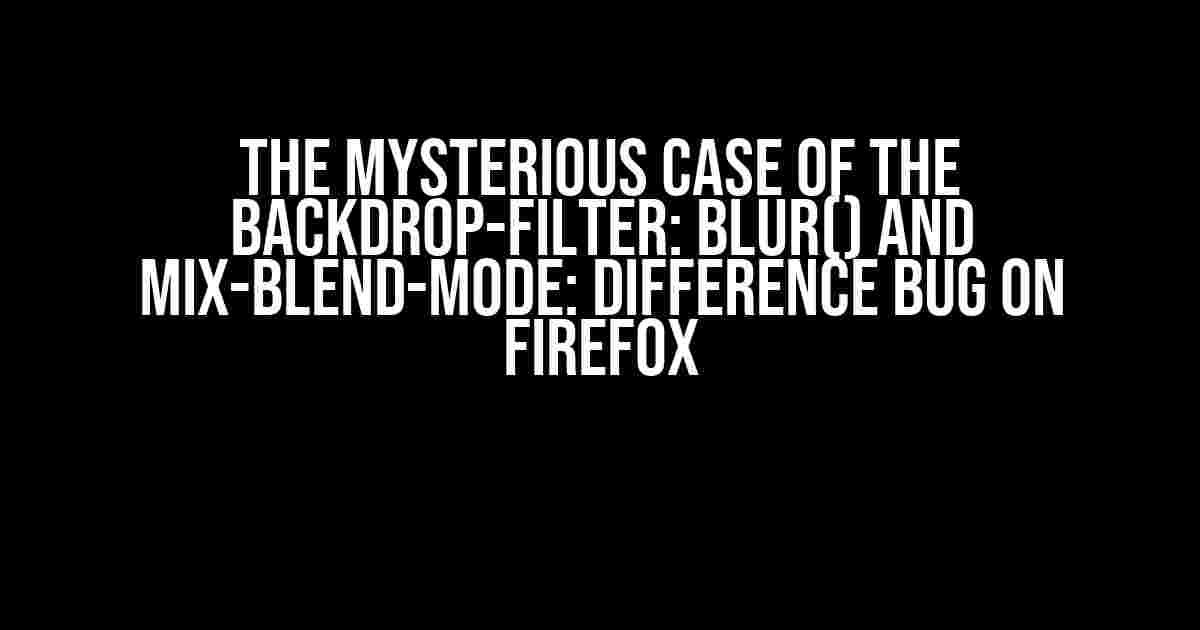If you’re a web developer or designer, you’ve likely encountered the mesmerizing effects of CSS filters and blend modes. However, when working with Firefox, you might have stumbled upon a peculiar bug that seems to defy logic – the infamous backdrop-filter: blur() and mix-blend-mode: difference bug. In this article, we’ll delve into the heart of the issue, explore possible causes, and provide step-by-step solutions to overcome this frustrating problem.
What’s the Bug, Anyway?
When using backdrop-filter: blur() in conjunction with mix-blend-mode: difference, Firefox versions 75 and above exhibit an unexpected behavior. Instead of producing the desired blurred background with a difference blend mode, the result is a weird, pixelated mess that looks more like a distorted image than a stylish effect.
A Little Background on CSS Filters and Blend Modes
Before we dive into the bug, let’s quickly review the basics of CSS filters and blend modes:
Backdrop-filter: blur(): A filter that applies a Gaussian blur effect to the element’s background.Mix-blend-mode: difference: A blend mode that subtracts the background color from the foreground color, creating an intriguing “difference” effect.
When used separately, these properties work as intended. However, when combined, the Firefox bug rears its head.
Theories Behind the Bug
Several theories have been proposed to explain the cause of this bug:
- Graphics Rendering Issue: Firefox’s graphics rendering engine might be struggling to handle the combination of blur and difference blend mode, resulting in the distorted output.
- Compositing Layers Conflict: The bug could be related to the way Firefox handles compositing layers, causing the blurred background to conflict with the foreground element’s blend mode.
- Browser-Specific Implementation: Firefox might have a unique implementation of backdrop-filter and mix-blend-mode that doesn’t play nicely together, leading to the bug.
Solutions to Overcome the Bug
While we wait for a official fix, we can employ some creative workarounds to achieve the desired effect:
Solution 1: Use an Alternative Blend Mode
Replace mix-blend-mode: difference with another blend mode that doesn’t trigger the bug, such as:
mix-blend-mode: multiply;This will give you a similar, albeit not identical, effect. You can experiment with other blend modes to find the one that suits your design.
Solution 2: Apply Blur Using a Pseudo-Element
Create a pseudo-element (e.g., ::before or ::after) with the blurred background:
.blurred-element::before {
content: "";
position: absolute;
top: 0;
left: 0;
width: 100%;
height: 100%;
filter: blur(5px);
z-index: -1;
}This approach ensures the blur effect is applied to a separate element, avoiding the conflict with the mix-blend-mode property.
Solution 3: Utilize a SVG Filter
Define an SVG filter to achieve the blur effect:
<svg>
<filter id="blur">
<feGaussianBlur in="SourceGraphic" stdDeviation="5" />
</filter>
</svg>
<div style="filter: url(#blur)">...</div>This method allows you to bypass the CSS filter altogether and use SVG’s built-in filtering capabilities.
Conclusion
The backdrop-filter: blur() and mix-blend-mode: difference bug on Firefox might be frustrating, but with a little creativity and experimentation, you can find workarounds to achieve the desired effect. Remember, the web development world is full of quirks and surprises, and it’s up to us to adapt and overcome them.
| Bug Status | Open ( awaiting official fix ) |
|---|---|
| Browser Affected | Firefox (versions 75 and above) |
| Possible Causes | Graphics rendering issue, compositing layers conflict, browser-specific implementation |
| Solutions | Alternative blend mode, pseudo-element with blur, SVG filter |
Stay tuned for updates on this bug, and don’t hesitate to share your own solutions and experiences in the comments below!
Here are 5 questions and answers about “backdrop-filter: blur() and mix-blend-mode: difference bug on Firefox” :
Frequently Asked Question
Get answers to the most frequently asked questions about the pesky backdrop-filter: blur() and mix-blend-mode: difference bug on Firefox!
What is the backdrop-filter: blur() and mix-blend-mode: difference bug on Firefox?
The backdrop-filter: blur() and mix-blend-mode: difference bug on Firefox is a rendering issue where the blur effect is not applied correctly when using backdrop-filter: blur() in combination with mix-blend-mode: difference. This results in a blurry mess instead of the desired effect.
Why does this bug occur only on Firefox?
This bug is specific to Firefox because of its unique rendering engine, Gecko. The bug is likely due to a rendering quirk in Gecko that affects the combination of backdrop-filter: blur() and mix-blend-mode: difference.
Is there a workaround for this bug?
Yes, you can use a workaround by applying the blur effect to a pseudo-element instead of the actual element. This involves creating a pseudo-element, applying the blur effect to it, and then positioning it behind the actual element.
Will this bug be fixed in future versions of Firefox?
The Mozilla team is aware of this bug and is working on a fix. However, there is no ETA on when the fix will be released. You can follow the bug report on Bugzilla to stay updated on the progress.
Are there any alternative browsers that don’t have this bug?
Yes, other browsers like Google Chrome and Microsoft Edge do not have this bug. However, it’s worth noting that Firefox is still a great browser with many unique features, and this bug is just a minor inconvenience.







